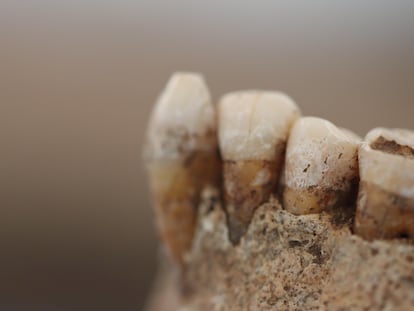Four minutes a day of intense exercise reduces the risk of mortality by 30%
Two recent studies could change the recommendations for physical activity as preventive medicine

What if your family doctor told you that doing two two-minute bursts of intense physical exercise from Monday to Friday could reduce your risk of cardiovascular disease by 40%? What if your cardiologist informed you, as someone who has cardiovascular risk factors such as diabetes or hypertension, that four two-minute bursts of vigorous exercise each day could cut your mortality risk by 27%?
In recent years, different studies have already shown that intense physical activity has greater benefits for cardiovascular health than less vigorous exercise. Now, two investigations, both published in the October issue of the European Heart Journal, which include UK Biobank data from over 70,000 adults, have the potential to “mark a before and after” in the recommendations for physical exercise as preventive medicine, says Dr. Fernando de la Guía, the coordinator of the Spanish Society of Cardiology’s Sports Cardiology working group and director of Cardiology at Spain’s Glorieta Dénia Clinic.
“These studies make the phrase ‘exercise is the best medicine’ clearer than ever,” observes the cardiologist. He highlights the importance of a differentiating factor in the new research: previous studies published on the subject used self-reports to determine the level of physical activity, “which is not at all accurate for delimiting the duration and intensity.” In contrast, the two investigations published in the European Heart Journal employed accelerometers to measure the movement and intensity of the study participants’ physical activity accurately and objectively.
“Questionnaire-based studies have suggested that 60 to 70 minutes a week of vigorous activity could reduce the risk of mortality by 30%. Dr. Matthew N. Ahmadi’s recent study suggests that a minimum amount of 20 minutes per week of vigorous ‘real’ physical activity offers similar lower levels of mortality risk. That is, there’s an approximate 3:1 equivalence of activity time as measured by questionnaires versus accelerometers,” De la Guía says.
The major benefits of short periods of intense physical activity
Research led by Dr. Ahmadi of the University of Sydney followed nearly 72,000 adults (56% of the subjects were female and the average age was 62.5) who did not have cardiovascular disease or cancer in the previous seven years. Researchers found that just 15 minutes of vigorous physical activity per week could reduce all-cause mortality and cancer risk by 15%.
Increasing exercise by another five minutes to a total of 20 minutes per week could slash the risk of heart disease by 40%. “The minimum dose of intense physical exercise for obtaining health benefits was approximately 15-20 minutes per week, but we have found additional health benefits up to approximately 50-60 minutes per week, where the optimal point would be found, with a 36% lower risk of death from any cause,” the author of the study explains to EL PAÍS.
The research also had another major finding. According to the data from the accelerometers, these health benefits can accrue through short bursts of intense physical activity of up to two minutes in duration. “One of the most unique results of our study was to find that intense physical activity did not need to accumulate over prolonged periods of time for health benefits. Therefore, any physical activity a person engages in provides the opportunity for vigorous physical activity if he or she can perform the activity at a faster pace or with greater intensity for short periods of time. This can be particularly important for people who don’t have time or don’t want to go to a gym or do traditional exercise,” notes Dr. Ahmadi.
“Even among people who are in poor physical condition and have cardiovascular risk factors [diabetes, hypertension, obesity, etc.], doing this vigorous exercise in short time intervals of up to two minutes four times a day reduces mortality by 27%,” Dr. Fernando de la Guía explains enthusiastically. The doctor notes that pills and medicine do not offer such impressive results. “Now, there’s no longer the excuse of not having time, because everyone can do small amounts of vigorous exercise during the day over the course of a week,” de la Guía adds.
Prioritize intensity without neglecting quantity
After following over 80,000 adults (the average age of participants was 62 years old, 58% of whom were women) for almost seven years, the second study suggests a similar conclusion. After analyzing accelerometer data, the researchers found that the total volume of physical activity was closely associated with a decreased risk of cardiovascular disease. In addition, they found that the greater the proportion of physical activity through moderate or intense exercise, the more cardiovascular risk declined.
“We found that when overall physical activity levels were doubled, there was no significant effect on cardiovascular disease rates when the proportion of moderate or intense physical activity remained at 10% of the total. However, the risk of cardiovascular disease did decrease by 23% and 40% when the proportion of moderate to vigorous physical activity increased to represent, respectively, 20% and 40% of the total,” the study’s lead author, Dr. Paddy C. Dempsey, a researcher at the British universities of Leicester and Cambridge, says in an e-mail.
Despite this data, however, Dempsey prefers not to speak of a “paradigm shift” in exercise recommendations for health. “One could interpret the results as a ‘quality versus quantity’ counterargument for improving cardiovascular disease health. For some, this may be useful, especially if they are pressed for time. However, to me, it would be a mistake to say that ‘volume doesn’t matter,’ as intensity and volume are intrinsically related. Instead of pitting quality against quantity, I would be more in favor of talking about different options or pathways with which to achieve benefits through physical exercise, so that each person can choose or gravitate toward the approach that works best for them,” the scientist explains.
Dr. Fernando de la Guía agrees with Dempsey that these recommendations offer the correct connection between intensity and volume. In other words, they clarify that walking at a slow pace is different from walking at a brisker pace. “These two studies confirm that every movement counts, and that a little exercise is better than none to improve our health. But now we also know that the intensity of physical activity plays an important role, even more so than the total volume of exercise,” he concludes.
How to measure the intensity of physical activity
How does one know if the exercise s/he is doing is light, moderate or intense? Dr. Fernando de la Guía explains that the intensity of physical activity is measured in METs, which is the metabolic expenditure or oxygen consumption per minute for an adult person at rest. One MET is equivalent to 3.5 ml O2/kg/min.
Up to 3 METs of oxygen consumption per minute refers to light activity. This level includes household activities as well as those that involve sitting or resting most of the time. Some examples are watching television while lying down, sitting while working on the computer or reading, or standing while ironing or dressing. Walking slowly on flat terrain without pushing the pace also qualifies as light activity.
Between 3 and 6 METs refers to moderate physical activities. These include certain household chores that involve more movement (sweeping, vacuuming, mopping the floor), as well as going up or down stairs while carrying light objects. Some light physical activities (table tennis, golf) and other activities done at moderate intensity (e.g., dancing, hiking, soccer, basketball and tennis) also fall into this category.
Activities done at 6 METs or more are considered intense or vigorous exercise. These include high-volume loading and unloading work, high-intensity farming or gardening tasks, running up or down stairs, and any other physical activity (running, aerobics, swimming, skiing, climbing, or playing soccer, basketball or any other sport) performed at an intense level.
Tu suscripción se está usando en otro dispositivo
¿Quieres añadir otro usuario a tu suscripción?
Si continúas leyendo en este dispositivo, no se podrá leer en el otro.
FlechaTu suscripción se está usando en otro dispositivo y solo puedes acceder a EL PAÍS desde un dispositivo a la vez.
Si quieres compartir tu cuenta, cambia tu suscripción a la modalidad Premium, así podrás añadir otro usuario. Cada uno accederá con su propia cuenta de email, lo que os permitirá personalizar vuestra experiencia en EL PAÍS.
¿Tienes una suscripción de empresa? Accede aquí para contratar más cuentas.
En el caso de no saber quién está usando tu cuenta, te recomendamos cambiar tu contraseña aquí.
Si decides continuar compartiendo tu cuenta, este mensaje se mostrará en tu dispositivo y en el de la otra persona que está usando tu cuenta de forma indefinida, afectando a tu experiencia de lectura. Puedes consultar aquí los términos y condiciones de la suscripción digital.











































